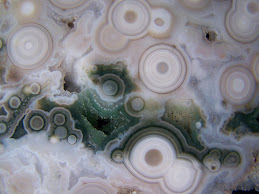Saturday, November 10, 2007
Artwork from God
Rocks and minerals attract people of all ages for a variety of reasons, but the visual appeal is paramount. Crystals, due to their smooth sparkling faces and interesting colors always draw the eye, but the more sophisticated afficionados of rocks soon learn about jaspers and agates. Truly, jaspers and agates--the crypto-crystalline chalcedonies--are my favorite rocks. The ranges of colors and designs in jaspers probably exceeds those found in agates, and for many people, a slice of jasper that has been wet or polished resembles an abstrace expressionist painting. This is especially true of such jaspers as morrisonite, chapenite, Stone Canyon jasper, and Bruneau jasper. However, there are a slew of so-called picture jaspers, whose designs often resemble landscapes. The most desirable of these include Biggs, Deschutes, Willow Creek, Wildhorse, Owyhee. For the jasper collector, a slice or two of these species are must-haves. Don't you agree?
Wednesday, October 17, 2007
Welcome to the blog
Jasper-Hound has been writing articles for Rock and Gem magazine, and it turns out that writing about rocks is addicting. Who would have thunk it? I have spent the morning composing an article about landscaping with gem and mineral materials and am debating where to publish it--in Rock and Gem or elsewhere. Other publications are expressing some interest, so we'll see. Interestingly, the most time consuming aspect for any article seems to be the photography, which often necessitates travel arrangements. But I digress...
How does one landscape with Gemstone materials? Just throw a handful of diamonds or rubies across the yard? Aren't those gemstones? The fact is, a lot of rocks can be turned into gemstones. Gemstone materials are generally those regarded as suitable for cutting and polishing for jewelry stones. Of course, the precious gemstones, such as diamonds, emeralds, sapphires, and rubies come to mind, but there is also a wide range of “decorative” or “semi-precious” materials, such as jade or carnelian, that have appeared in valuable jewelry from the time of the ancient Egyptians to the present. Since the dawn of modern abrasive technology in the middle of the last century, more and more of these stones have been machined into home décor pieces, such as bookends, spheres, polished slabs, obelisks, pyramids, and even clock faces. In recent years, spectacular polished amethyst geode halves (commonly called “cathedrals”) have been appearing in people’s homes and offices.
Some basic nomenclature, then, for any of you neophytes who read this:
A mineral is a solid, homogeneous chemical crystalline element or compound. The key word there is homogeneous; a mineral cannot be a mixture of different compounds. Interestingly, technically ice is a mineral.
A rock is a stoney mass of consolidated or unconsolidated mineral material. Rocks can include one or several minerals.
A gemstone is a mineral or rock of sufficient hardness to be polished and rarity to be valuable.
Precious gems are usually clear, very hard, and very rare, such as emerald. Other gemstones are more accurately called decorative stones due to less rarity. Such stones, such as agate or jasper, are usually cut en cabochon, in a smooth domed form, rather than faceted.
In case you could not tell, the Jasper-Hound's favorite gemstone material is jasper. This is due to the infinitude of colors and designs seen in the jaspers of the world. In addition, some jasper has become extremely rare and valuable, in particular such materials as Deschutes jasper and Morrisonite. More on these subspecies later.
How does one landscape with Gemstone materials? Just throw a handful of diamonds or rubies across the yard? Aren't those gemstones? The fact is, a lot of rocks can be turned into gemstones. Gemstone materials are generally those regarded as suitable for cutting and polishing for jewelry stones. Of course, the precious gemstones, such as diamonds, emeralds, sapphires, and rubies come to mind, but there is also a wide range of “decorative” or “semi-precious” materials, such as jade or carnelian, that have appeared in valuable jewelry from the time of the ancient Egyptians to the present. Since the dawn of modern abrasive technology in the middle of the last century, more and more of these stones have been machined into home décor pieces, such as bookends, spheres, polished slabs, obelisks, pyramids, and even clock faces. In recent years, spectacular polished amethyst geode halves (commonly called “cathedrals”) have been appearing in people’s homes and offices.
Some basic nomenclature, then, for any of you neophytes who read this:
A mineral is a solid, homogeneous chemical crystalline element or compound. The key word there is homogeneous; a mineral cannot be a mixture of different compounds. Interestingly, technically ice is a mineral.
A rock is a stoney mass of consolidated or unconsolidated mineral material. Rocks can include one or several minerals.
A gemstone is a mineral or rock of sufficient hardness to be polished and rarity to be valuable.
Precious gems are usually clear, very hard, and very rare, such as emerald. Other gemstones are more accurately called decorative stones due to less rarity. Such stones, such as agate or jasper, are usually cut en cabochon, in a smooth domed form, rather than faceted.
In case you could not tell, the Jasper-Hound's favorite gemstone material is jasper. This is due to the infinitude of colors and designs seen in the jaspers of the world. In addition, some jasper has become extremely rare and valuable, in particular such materials as Deschutes jasper and Morrisonite. More on these subspecies later.
Subscribe to:
Posts (Atom)
